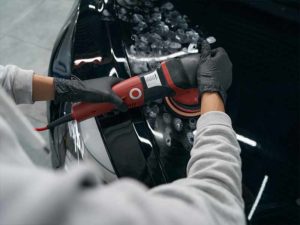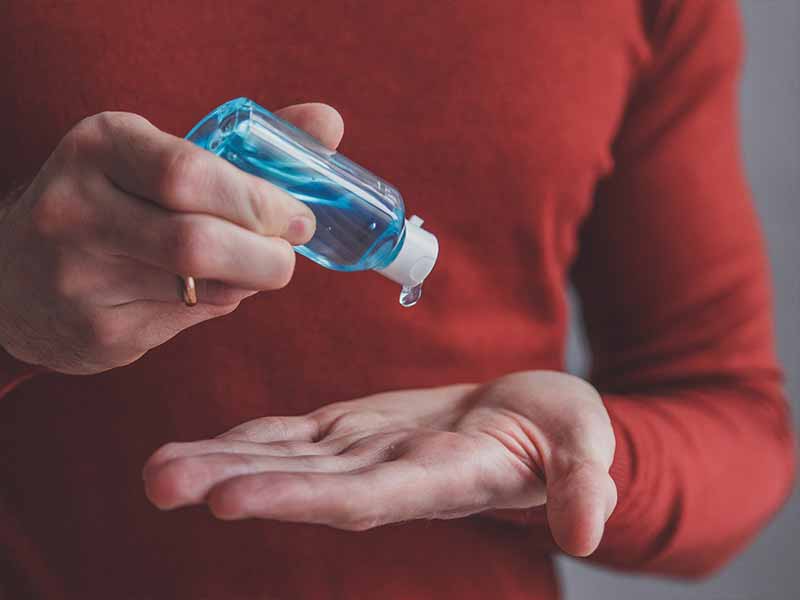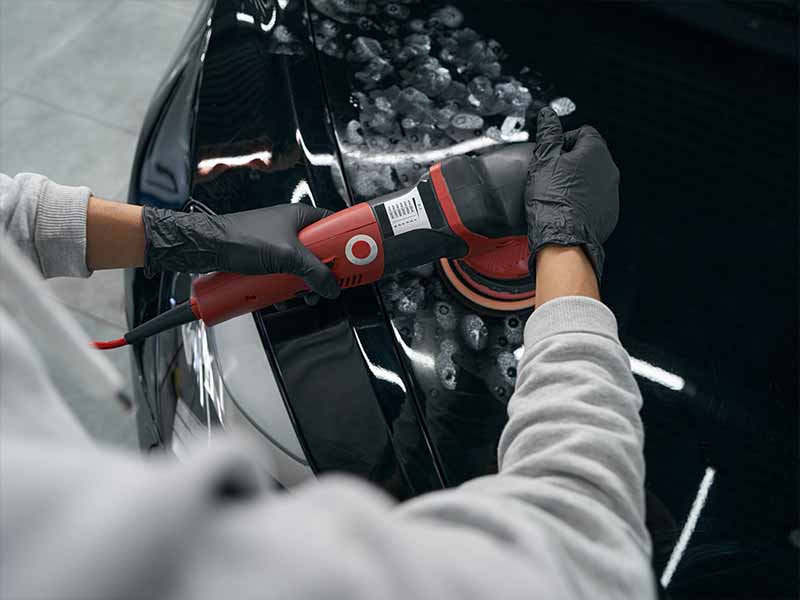Table of Contents
So, you’re car or truck got scratched and you’re wondering what it’s going to take to fix it. It depends on just how deep the scratch penetrated.
Scratch removal is a very DIY-friendly job when the scratches are at surface level. Light scratches can usually be polished out. Moderately deep scratches usually need more than just a little buffing to fix.
Continue reading to learn how to easily tell if a scratch can be buffed out and which ones will need touching up.
How Deep Of A Scratch Can Be Buffed Out?
Scratches that haven’t penetrated through the thin clear coat layer of your paintwork can be polished away. Anything deeper will need touch up paint to repair.
You can tell if a scratch has gone through the clear coat by using the fingernail test. If you run your fingernail across the scratch and it catches in the scratch groove, it’s gone through the clear coat at least and will need touch up paint.
Types Of Car Scratches
There are several layers protecting the car’s surface, and scratches can penetrate to any one of these layers. The upper most layer that protects the color layer is the clear coat. Scratching this layer is minor and won’t require much elbow grease to fix; however, the clear coat protects the paint layer from UV rays, so it’s worth paying attention to.
The layer underneath the clear coat is the paint or color layer. Getting a scratch in the body paint can be a little more problematic. Once the clear coat has been penetrated you’ll need to use touch up paint to properly fix the scratched area.
After the paint layer is the primer. If you have a primer scratch, you might see white, off-white, or grey beneath the paint. This will also require touching up to properly restore.
Finally, underneath the primer coating is the bare metal or plastic body panel. Left untreated, a scratch at this level can cause rust if the panel is metal. This type of scratch is should be fixed. It’s not just a superficial blemish. This type of scratch too will require touching up with a touch up paint kit.
Scratches that penetrate beyond the clear coat and into any of the different layers beyond or all the way down to the body panel will need touching up to properly fix. Only surface level clear coat scratches can be polished out.

Clear Coat Scratches
Pretty much anything can cause a clear coat scratch, including washing, touching, leaning against, etc. Thankfully, nothing more than a little bit of polishing can remove clear coat scratches like magic.
To fix a superficial clear coat scratch, wash and dry the car, then apply scratch remover like Meguiar’s Ultimate Compound to a microfiber cloth and rub into the scratched area in a circular motion for around a minute. Let it dry before removing it with another microfiber cloth. Repeat the process until the scratch is gone.

Exposed Paint Color Scratches
For deeper clear coat scratches that go all the way into the paint layer, you’ll need more than a microfiber towel. Touch up paint is the best solution for anything beyond the clear coat. The level of effort required to apply it and blend it in well will go up the deeper the scratch.
Touching up scratches that have barely penetrated through to the paint layer likely won’t need any wet sanding or rubbing compound. Just a little polishing compound once touched up should be enough for most of these minor car scratches.
Exposed Primer (Base Coat) Scratches
To fix deep scratches that extend into the primer, you’ll want to wet sand the edges of the scratch down and then use thin layers touch up to fill the scratch. A decent amount of paint removal is required to smooth the transition from the scratch to the original paint.
Once the scratch has been sanded smooth you can then fill the scratch with thin color paint layers until it is layered above the height of the original paint.
Wet sand this until smoothed with the original paint and repeat this process by applying thin clear coat paint layers on top. Wet sand the clear layers smooth with the original paint and clean with some isopropyl rubbing alcohol.
Apply rubbing compound and polish on the entire panel to restore a factory-like shine and smooth out the paint job fix.
Exposed Metal Scratches
Bare metal or exposed plastic body panel scratches aren’t any different to fix than primer scratches. The same method outlined above will work. It’s a laborious process that you may prefer to leave to a body shop, but if you want to save a quite a bit of money and have the time, patience, and skill it can done by yourself at home.
How can you tell if a scratch can be buffed out?
With minor scratches, it can be difficult to tell if it is too deep to buff out without getting out the sandpaper. Surface scratches are pretty easily identifiable, but if it extends to the paint, you may have more work on your hands.
A good rule of thumb to test the depth of scratches that can be repaired with buffing is to use the fingernail test.
Car Scratch Fingernail Test
Most scratches on a car that haven’t been in an accident or vandalised are clear coat scratches. If the scratch is just in the car’s clear coat, it can be fixed with a a little rubbing compound, polish, and a buffing pad.
To figure out if small scratches shallow enough to be buffed out, run your fingernail over the scratch several times to see if it catches. If it doesn’t, you can fix these with a typical scratch removal kit that is essentially just some polish and a buffing pad.
If your fingernail does catch, scratch repair will require a lot more work.
Does buffing remove scratches permanently?
Swirls and fine scratches are common and collect easily on your car surface. They dull your finish and make paint look weathered. Fortunately these minor scratches can easily be buffed away.
Light scratches or swirl marks on your car can be permanently removed with buffing. This process removes a thin amount from the car surface. Medium scratches that go deeper and penetrate past the clear coat and into the paint cannot be permanently fixed with buffing alone.

Can Deep Car Scratches Be Repaired?
Any scratch can be repaired. Deep scratches, shallow scratches, it’s just a matter of time and money. The real question is, is it practical to repair deep scratches yourself at home.
The answer to this question depends on whether you have the patience to do it yourself. Any scratch that has penetrated beyond the thin layer of clear urethane on the surface of your car’s paintwork is going to require several hours of labor. You’ll also need to wait for the thin layers of paint that you apply to dry before applying the next layer and you’ll need them to dry before sanding or polishing.
Most of the time, deep scratches need to be entrusted to a repair shop, but they can be repaired.
What does a deep paint scratch look like?
A deep paint scratch looks different from the adjacent color even from afar. The color may be slightly different, lighter or darker in color from the color around it, or it may be exposing a white or grey color through the scratch.
If the scratch is revealing a dark gray color, it’s past the paint and into the primer or all the way to the surface of the bare metal or plastic beneath.
What is considered a deep scratch?
Scratches on a car that go through the clear coat and into the paint are considered deep.
Can a deep scratch be buffed out?
No. To fix a deep scratch, repair will require more than buffing and polishing. This process requires sanding, touch up paint, and a lot of time and effort.
Deep scratches are not quickly fixable at home but the job isn’t hard. It just takes time and patience to be done correctly. If you don’t have the patience or desire to tackle this job yourself a body shop is your best choice.
A body shop will get better results than a touch up job since they’ll sand down the entire area and repaint it. This allows them to blend in the color of the new paint with the original factory paint job.
How do you buff a scratch out of a car?
Repairing a scratch by buffing it will only work on superficial car scratches that barely dip into the clear coat. Fixing clear coat scratches is fairly simple.
How To Fix Clear Coat Scratches
- Wash and thoroughly dry the car
- Apply a small amount of scratch remover to a microfiber rag
- Using a circular motion, rub the remover into the scratch
- Remove excess and wait for it to dry
- Reapply if necessary
For deeper clear coat scratches, you may have to use a more comprehensive process.
- Wash and thoroughly dry the car
- Sand the scratch with wet sandpaper
- Use rubbing compound with a foam pad
- Apply polish with a polishing pad until it’s shiny
Frequently Asked Questions
Can detailers remove scratches?
Car detailers often provide a service called paint correction. Paint correction deals with removing fine swirls and scratches as well as other blemishes and paint defects.
Some detailers will also apply touch up paint and fix more severe scratches.
Not all detailers will offer services beyond repairing superficial surface scratches and defects. You’ll need to check with your detailer to see what type of scratch repair services they offer.
Does car wax remove scratches?
Car wax only protects the car, but cannot do anything to fix scratches on your car.
Will a clay bar remove scratches?
No. A clay bar can do several things for a car, including smoothing out the surface and removing oxidation, but it cannot remove scratches.
Does insurance cover scratches on car?
Insurance will only cover the repair for scratches on your car if they are related to an accident that’s covered on your policy. The good news is, paint scratches that extend below the surface are often caused by accidents or vandalism that may be covered in your policy, so insurance is more likely to cover the cost to fix deep scratches by association with accidents.
How long does it take to buff out a scratch?
From a few minutes to twenty minutes, the amount of time it takes varies for the depth of the scratch. Light car scratches that don’t cut deep can be buffed out quicker than car scratches that do.

Conclusion
Whether you’re distraught about that scratch to your new car or can’t stand what you’ve done to ol’ faithful, there are ways to repair the damage with minimal expense.
Remember, only clear coat scratches have a hope of being buffed out, but that doesn’t mean deeper scratches are without hope.
For clear coat scratches, a bit of scratch remover with a buff and wax can make your car look like new. For deeper scratches, some sanding may be required to even things out.









